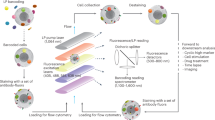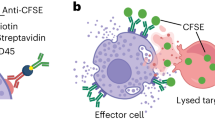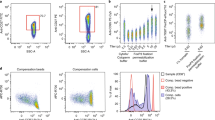Abstract
Immune responses arise from a wide variety of cells expressing unique combinations of multiple cell-surface proteins. Detailed characterization is hampered, however, by limitations in available probes and instrumentation. Here, we use the unique spectral properties of semiconductor nanocrystals (quantum dots) to extend the capabilities of polychromatic flow cytometry to resolve 17 fluorescence emissions. We show the need for this power by analyzing, in detail, the phenotype of multiple antigen-specific T-cell populations, revealing variations within complex phenotypic patterns that would otherwise remain obscure. For example, T cells specific for distinct epitopes from one pathogen, and even those specific for the same epitope, can have markedly different phenotypes. The technology we describe, encompassing the detection of eight quantum dots in conjunction with conventional fluorophores, should expand the horizons of flow cytometry, as well as our ability to characterize the intricacies of both adaptive and innate cellular immune responses.
This is a preview of subscription content, access via your institution
Access options
Subscribe to this journal
Receive 12 print issues and online access
$209.00 per year
only $17.42 per issue
Buy this article
- Purchase on Springer Link
- Instant access to full article PDF
Prices may be subject to local taxes which are calculated during checkout




Similar content being viewed by others
References
Perfetto, S.P., Chattopadhyay, P.K. & Roederer, M. Seventeen-colour flow cytometry: unravelling the immune system. Nat. Rev. Immunol. 4, 648–655 (2004).
Roederer, M. Compensation is not dependent on signal intensity or on number of parameters. Cytometry 46, 357–359 (2001).
Roederer, M. Spectral compensation for flow cytometry: visualization artifacts, limitations, and caveats. Cytometry 45, 194–205 (2001).
Bruchez, M., Jr ., Moronne, M., Gin, P., Weiss, S. & Alivisatos, A.P. Semiconductor nanocrystals as fluorescent biological labels. Science 281, 2013–2016 (1998).
Hotz, C.Z. Applications of quantum dots in biology: an overview. Methods Mol. Biol. 303, 1–17 (2005).
Michalet, X. et al. Quantum dots for live cells, in vivo imaging, and diagnostics. Science 307, 538–544 (2005).
Lim, Y.T. et al. Selection of quantum dot wavelengths for biomedical assays and imaging. Mol. Imaging 2, 50–64 (2003).
Goldman, E.R., Mattoussi, H., Anderson, G.P., Medintz, I.L. & Mauro, J.M. Fluoroimmunoassays using antibody-conjugated quantum dots. Methods Mol. Biol. 303, 19–34 (2005).
Chan, W.C. & Nie, S. Quantum dot bioconjugates for ultrasensitive nonisotopic detection. Science 281, 2016–2018 (1998).
Brenchley, J.M. et al. Expression of CD57 defines replicative senescence and antigen-induced apoptotic death of CD8+ T cells. Blood 101, 2711–2720 (2003).
Appay, V. et al. Memory CD8+ T cells vary in differentiation phenotype in different persistent virus infections. Nat. Med. 8, 379–385 (2002).
Chen, G. et al. CD8 T cells specific for human immunodeficiency virus, Epstein-Barr virus, and cytomegalovirus lack molecules for homing to lymphoid sites of infection. Blood 98, 156–164 (2001).
Champagne, P. et al. Skewed maturation of memory HIV-specific CD8 T lymphocytes. Nature 410, 106–111 (2001).
Sallusto, F. et al. Two subsets of memory T lymphocytes with distinct homing potentials and effector functions. Nature 401, 708–712 (1999).
Chattopadhyay, P.K. & Roederer, M. Immunophenotyping of T cell subpopulations in HIV disease. in Current Protocols in Immunology, Vol. Unit 12.12 (2005).
De Rosa, S.C., Herzenberg, L.A. & Roederer, M. 11-color, 13-parameter flow cytometry: identification of human naive T cells by phenotype, function, and T-cell receptor diversity. Nat. Med. 7, 245–248 (2001).
Hamann, D. et al. Phenotypic and functional separation of memory and effector human CD8+ T cells. J. Exp. Med. 186, 1407–1418 (1997).
Amlot, P.L., Tahami, F., Chinn, D. & Rawlings, E. Activation antigen expression on human T cells. I. Analysis by two-colour flow cytometry of umbilical cord blood, adult blood and lymphoid tissue. Clin. Exp. Immunol. 105, 176–182 (1996).
Plaeger-Marshall, S. et al. Activation and differentiation antigens on T cells of healthy, at-risk, and HIV-infected children. J. Acquir. Immune Defic. Syndr. 6, 984–993 (1993).
Sing, G., Butterworth, L., Chen, X., Bryant, A. & Cooksley, G. Composition of peripheral blood lymphocyte populations during different stages of chronic infection with hepatitis B virus. J. Viral Hepat. 5, 83–93 (1998).
Rowland-Jones, S.L. et al. An antigen processing polymorphism revealed by HLA-B8-restricted cytotoxic T lymphocytes which does not correlate with TAP gene polymorphism. Eur. J. Immunol. 23, 1999–2004 (1993).
Price, D.A. et al. Positive selection of HIV-1 cytotoxic T lymphocyte escape variants during primary infection. Proc. Natl. Acad. Sci. USA 94, 1890–1895 (1997).
Diamond, D.J., York, J., Sun, J.Y., Wright, C.L. & Forman, S.J. Development of a candidate HLA A*0201 restricted peptide-based vaccine against human cytomegalovirus infection. Blood 90, 1751–1767 (1997).
Scotet, E. et al. T cell response to Epstein-Barr virus transactivators in chronic rheumatoid arthritis. J. Exp. Med. 184, 1791–1800 (1996).
Hutchinson, S.L. et al. The CD8 T cell coreceptor exhibits disproportionate biological activity at extremely low binding affinities. J. Biol. Chem. 278, 24285–24293 (2003).
Ballou, B., Lagerholm, B.C., Ernst, L.A., Bruchez, M.P. & Waggoner, A.S. Noninvasive imaging of quantum dots in mice. Bioconjug. Chem. 15, 79–86 (2004).
Jaiswal, J.K., Mattoussi, H., Mauro, J.M. & Simon, S.M. Long-term multiple color imaging of live cells using quantum dot bioconjugates. Nat. Biotechnol. 21, 47–51 (2003).
Rieger, S., Kulkarni, R.P., Darcy, D., Fraser, S.E. & Koster, R.W. Quantum dots are powerful multipurpose vital labeling agents in zebrafish embryos. Dev. Dyn. 234, 670–681 (2005).
Perfetto, S.P., Ambrozak, D.R., Roederer, M. & Koup, R.A. Viable infectious cell sorting in a BSL-3 facility. Methods Mol. Biol. 263, 419–424 (2004).
Acknowledgements
We are grateful to the members of the Laboratory of Immunology at the Vaccine Research Center for their continuing enthusiasm, support and critical suggestions during the development of these technologies. We gratefully acknowledge the assistance of L. Duckett (BD Biosciences) and P. Millman (Chroma Technology Corp.) in optimizing the instrumentation and optics for detection of the quantum dot reagents. D. Price is a Medical Research Council (MRC) Clinician Scientist. Quantum dot materials were developed with partial support from the US National Institutes of Health/National Institute of Biomedical Imaging and BioEngineering Research Partnership program (R01 EB 000364) and the National Institute of Standards and Technology Advanced Technology Program (70NANB0H3000). This work is supported by the Intramural Research Program of the US National Institutes of Health, Vaccine Research Center, National Institute of Allergy and Infectious Diseases.
Author information
Authors and Affiliations
Contributions
P.K.C. designed and performed experiments, and wrote the manuscript. M.P.B. and M.R. designed experiments. D.A.P., T.F.H., M.R.B., J.Y., E.G., S.P.P., P.G., R.A.K., and S.C.D. provided instrumentation, reagent manufacture and validation, and sample support. All authors reviewed and edited the manuscript.
Corresponding author
Ethics declarations
Competing interests
The authors declare no competing financial interests.
Supplementary information
Supplementary Table 1
Summary of phenotypes of antigen-specific CD8 T cells. (PDF 58 kb)
Supplementary Table 2
Reagents used in 17-color staining panel. (PDF 58 kb)
Rights and permissions
About this article
Cite this article
Chattopadhyay, P., Price, D., Harper, T. et al. Quantum dot semiconductor nanocrystals for immunophenotyping by polychromatic flow cytometry. Nat Med 12, 972–977 (2006). https://doi.org/10.1038/nm1371
Received:
Accepted:
Published:
Issue Date:
DOI: https://doi.org/10.1038/nm1371
This article is cited by
-
Label-free detection of biomolecules using inductively coupled plasma mass spectrometry (ICP-MS)
Analytical and Bioanalytical Chemistry (2024)
-
Quantum Dot Nanomaterials: Preparation, Characterization, Advanced Bio-Imaging and Therapeutic Applications
Journal of Fluorescence (2023)
-
Comprehensive single-shot biophysical cytometry using simultaneous quantitative phase imaging and Brillouin spectroscopy
Scientific Reports (2022)
-
Mapping Cell Phenomics with Multiparametric Flow Cytometry Assays
Phenomics (2022)
-
Random access DNA memory using Boolean search in an archival file storage system
Nature Materials (2021)



